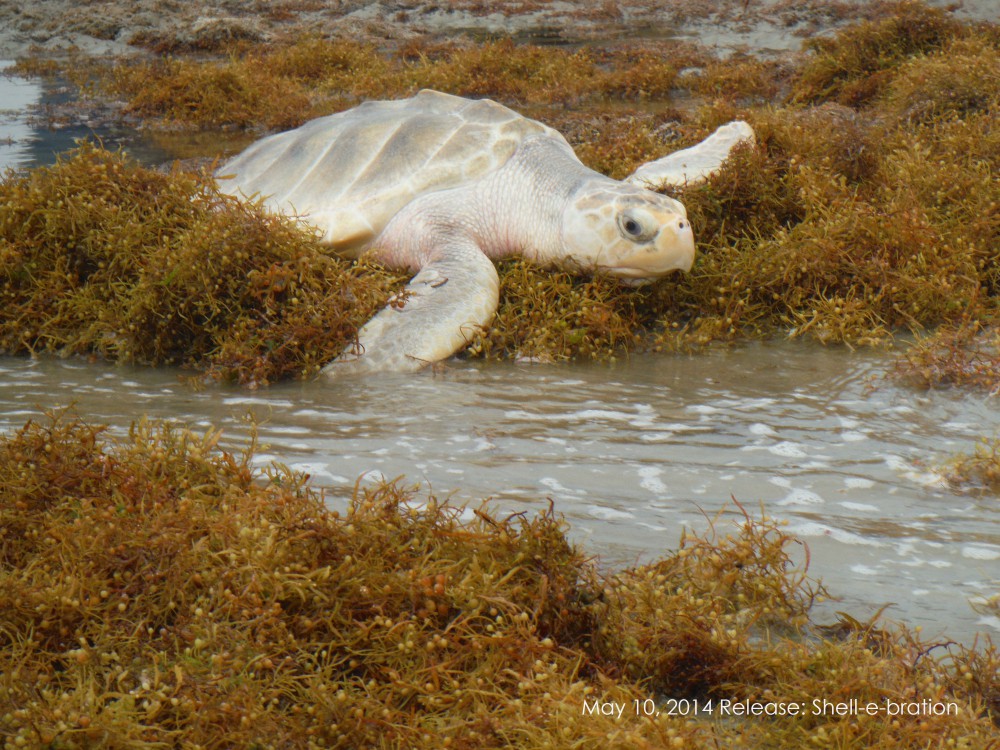The small sea turtle that calls the Gulf of Mexico its “home,” is known to many as the “Heartbreak Turtle.” The Kemp’s Ridley sea turtle continues to break our hearts because just as soon as its population starts to grow and start to leave the threat of extinction behind, it is set back again.

Photo by Ron Wooten.
Trouble for the Kemp’s ridley sea turtle started when people in Mexico discovered their nesting beach on the Gulf side of their country. Scores of people waited for nesting season, and then stole their eggs from the beaches for food and for income. When the shrimp fleet grew in both Mexican and U.S. waters, thousands of sea turtles were caught in trawls and drowned.
The population of the Heartbreak Turtle just couldn’t take it. Years passed and the number of nesting Kemp’s ridley sea turtles declined, but was not totally overlooked. Sea turtle pioneer Ila Loetscher of Port Isabel, Texas, and her friends tried to move eggs to the U.S. before they were all taken. Both U.S. and Mexican scientists became aware of their efforts. Although many people in both countries can be proud of their work to save the turtles from extinction, two people come to my mind first – Dr. Rene Marquez of Mexico and Jack Woody, retired from the U.S. Fish and Wildlife Service (and founding Board member of Turtle Island Restoration Network).
With their networks in both governments, a daring plan came about. Each year, at least 2,000 ridley eggs were carefully moved from Mexico to the Padre Island National Seashore in Texas. Here the eggs were carefully hatched and then raised or “headstarted” in Galveston, Texas, for about a year. The result was thousands of healthy ridleys hatchlings protected from crabs on the beaches as and seagulls swooping in for lunch.
Although the Endangered Species Act (ESA) in the U.S. was supposed to protect sea turtles, it took years to force the shrimp industry to implement Turtle Excluder Devices (TEDs), an interesting device that allows sea turtles to escape drowning when caught in shrimp trawls. Even today, shrimpers are allowed to use skimmer trawls without TEDs in a system allowing them to time the tow, and give any captured sea turtles a chance to escape. This system, seen as tragically comical to many of us, assumes that shrimpers keep an eye on their watches to make sure a net with a turtle caught in it doesn’t stay in the water too long. We are still pushing the National Marine Fisheries Service for needed changes.
Eventually, the Kemp’s ridley population began to grow, and scientists and conservationist were encouraged. Government agencies were even talking about down listing the species from ESA protection. Then came April 2010 with the most tragic blow to the environment of the Gulf of Mexico ever recorded.
An oil well owned by British Petroleum (BP) blew up, killing 11 workers, and pouring millions of gallons of oil in the Gulf (coating beaches, marshes, estuaries and unknown numbers of creatures). Pelicans and seagulls coated with oil were shown on television channels around the world. Volunteers and government  workers rushed to do what they could to save animals. Meanwhile in the Gulf, sea turtles were being coated with oil, and caught in the middle of efforts to collect and burn oil. Turtle Island Restoration Network immediately filed a lawsuit with animal welfare groups to stop the burning, and look for sea turtles that could be helped. Meanwhile unethical shrimpers took advantage of the chaotic situation to go shrimping without TEDs since they knew law enforcement was pre-occupied. Hundreds of Kemp’s ridleys with no signs of oil washed up on Mississippi beaches before fishing was stopped.
workers rushed to do what they could to save animals. Meanwhile in the Gulf, sea turtles were being coated with oil, and caught in the middle of efforts to collect and burn oil. Turtle Island Restoration Network immediately filed a lawsuit with animal welfare groups to stop the burning, and look for sea turtles that could be helped. Meanwhile unethical shrimpers took advantage of the chaotic situation to go shrimping without TEDs since they knew law enforcement was pre-occupied. Hundreds of Kemp’s ridleys with no signs of oil washed up on Mississippi beaches before fishing was stopped.
Government agencies have scrambled to come up with numbers of dead sea turtles or possible effects to future generations, but it has been mostly a guess. Now, the Cooperative Institute for Marine and Atmospheric Studies at the University of Miami’s Rosenstiel School has come up with new and shocking numbers.
An estimate released to the media in December 2015 calculates that as many as 320,000 turtles including Kemp’s ridleys, greens and loggerheads have been impacted by the oil spill, not just in the Gulf but also where turtles migrate to South America and Western Africa.
This new estimate tells the shameful legacy of the Deepwater Horizon oil spill and the incredible harm it caused to Kemp’s ridley sea turtle populations. Turtle Island is keeping a close watch on these endangered turtles, and working to protect them through nesting beach patrols, legal actions and petitions.
If you’d like to help us continue to fight for the ‘heartbreak turtle’ please consider making a donation of any amount at seaturtles.org/donate.




